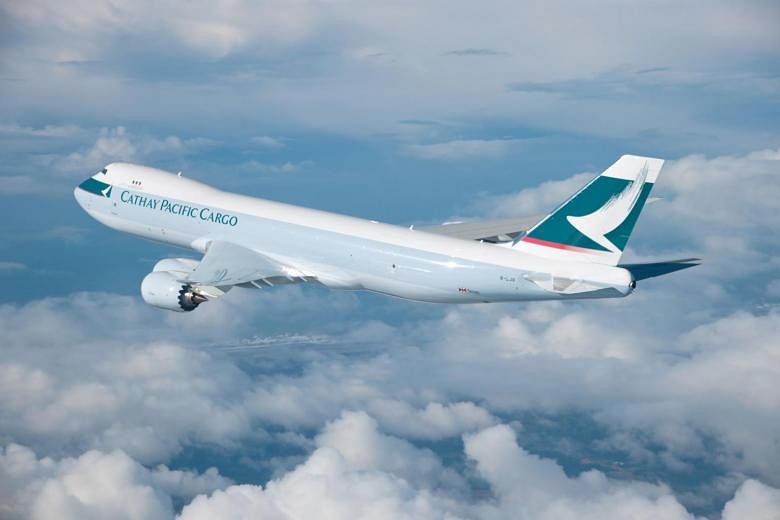BEIJING (BLOOMBERG) - Cathay Pacific Airways Ltd., Asia's largest international airline by passengers, reported net income that lagged behind analyst estimates after it had losses from fuel hedging and passenger yields dropped. .
Profit jumped to HK$1.97 billion (S$360 million) in the six months ended in June, below the HK$2.22 billion median estimate in a Bloomberg News survey of six analysts, Hong Kong-based Cathay said in a statement to the stock exchange Wednesday (Aug 19). That compared to net income of HK$347 million a year earlier. Sales in the first six months declined 0.9 per cent to HK$50.4 billion.
Cathay shares fell to their lowest intraday level since November after the results, which included a HK$3.74 billion loss from fuel hedges. Last year's slump in the crude oil market has left several Asian carriers holding hedges placed when oil prices were higher, adding to the challenges for chief executive officer Ivan Chu.
"It's a mixed set of earnings," said Mohshin Aziz, a Malayan Banking Bhd. analyst in Kuala Lumpur. "On the revenue side things were very weak, much weaker than expected. Fortunately on the cost side, they seem to be making a lot of improvements."
The airline had an unrealized fuel hedging loss of HK$7.42 billion at the end of June, Cathay said in the statement.
Cathay's shares fell by as much as 6 per cent and were down 4.9 per cent to HK$15.84 as of 1:09 pm in Hong Kong. The stock is dropping for an eighth consecutive day, the longest losing streak in more than two years.
Last year's sudden plunge in oil prices left several Asian carriers holding bets made when crude oil prices were around US$100 a barrel. Oil's drop and airlines' hedging losses are reminiscent of 2008 and 2009, when Cathay, Chinese carriers and Singapore Airlines all reported millions of dollars in losses because of their bets on fuel.
"Managing the risk associated with volatile fuel prices remains a priority," John Slosar, Cathay's chairman, said in the statement. "In the first half of 2015, lower fuel costs were partially offset by hedging losses."
In March, after Cathay announced it lost HK$911 million on fuel hedges in 2014, Mr Chu stressed that the company considered hedging an important part of its financial management and would stick with the practice. Only a portion of Cathay's fuel buys are locked in at a set price, so the airline still sees a net benefit if oil prices drop - and it's protected if they rise again steeply, he said. Fuel is the airline's single biggest expense.
The airline's fuel hedging extends to 2019, Cathay said in Wednesday's statement.
Passenger yields dropped 9.3 per cent in the first half from a year earlier, beyond the 5 per cent to 6 per cent decline expected by UOB Kay Hian Pte. and Malayan Banking Bhd. Yields dropped on all sectors, with those to North America 10.2 per cent and Europe 10.1 per cent posting the biggest declines, according to Cathay's statement.
Economy-class demand was strong on long-haul routes, Slosar said in the statement. Premium class demand was robust on short-haul routes but was weaker than expected on some long-haul routes.
"Strong competition, a significant reduction in fuel surcharges, foreign currency movements and the fact that a higher proportion of passengers were connecting through Hong Kong put downward pressure on yield," Slosar said.
Cathay has ordered new planes and has added more routes as it seeks to counter competition from the Middle East carriers and the Big Three from mainland China - Air China Ltd., China Southern Airlines Co. and China Eastern Airlines Corp.
Cathay's passenger numbers increased 8.8 per cent to 16.8 million in the first half of the year and occupancy increased to 85.9 per cent in that period.
"Cathay is leveraging effectively on the demand recovery for long-haul flights in and out of Hong Kong," Maybank's Mohshin wrote in an Aug. 10 note. "Its year-to-date passenger load factors are at record highs, while cargo load factor has shown good year-on-year improvement."
Yet there are challenges. First China's economy logged its slowest growth in more than 20 years. Then about US$3 trillion was wiped out from the country's stock market since mid-June. This month, the yuan was devalued.
With 60 per cent of Cathay's passengers starting their journeys in mainland China, any negative impact in the world's second-biggest economy is an issue for Asia's biggest international carrier.
"Even without the yuan change, mainland China was becoming increasingly challenging for Cathay as visitors considered other destinations and alternative stopover hubs," said Will Horton, a Hong Kong-based analyst at consultancy CAPA Centre for Aviation.
A 1 per cent drop in air-travel growth in China - poised to become the world's biggest market in two decades - could slash US$5.6 million from Cathay's annual profit, according to Credit Suisse Group AG estimates. That would be the biggest hit for any Asian carrier other than Singapore Airlines.

